Introduction
The Unfinished Temple of Segesta is a remarkable testament to ancient Sicily’s cultural richness and historical significance. While its builders remain unidentified, it is commonly attributed to the Elymian people, highlighting cultural interactions between Greek settlers and native Sicilian communities.
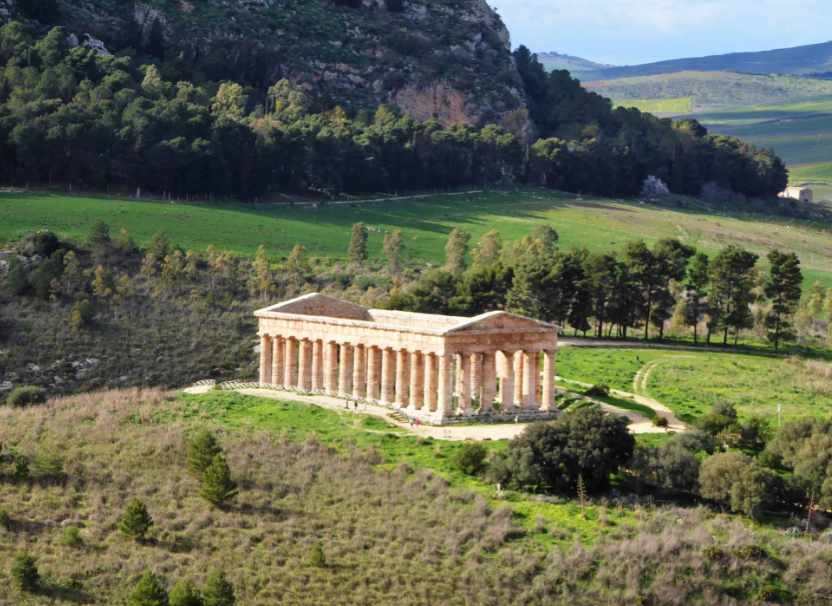
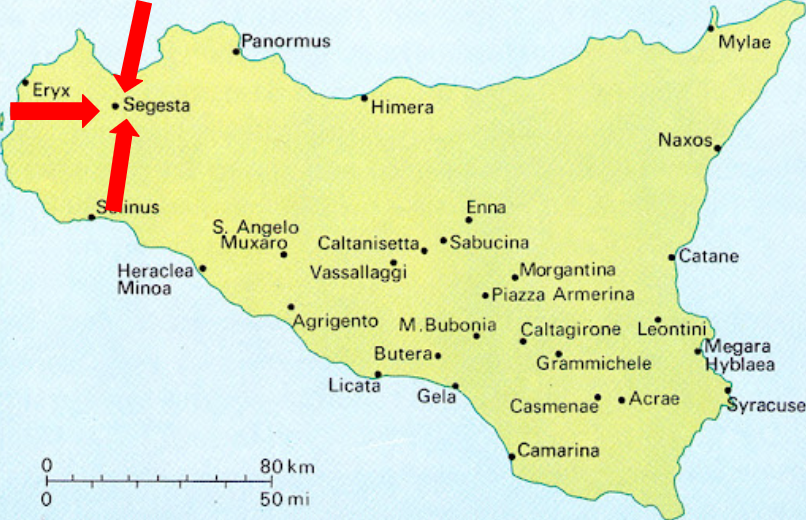
Purpose and Design
Builders and Purpose
The temple likely served religious and political purposes, symbolizing the power and prestige of the city-state of Segesta. Its construction underscores the complex cultural dynamics of ancient Sicily, where indigenous populations interacted with Greek settlers. These native Sicilians were known as Elymians, and the Greeks considered them descendents from the city of Troy. While some sources attribute its construction to the Athenians, the monument itself suggests a community effort rather than the work of a specific ruler or individual. If its constructruction was by an Athenian, the polis of Segesta most likely hired Greek craftsmen to physically build the temple, in combination with whatever laborers they provided.
Architectural Design of The Unfinished Temple of Segesta and Doric Style Temples
The temple featured a colonnaded exterior with 36 Doric columns crafted from local limestone. Its design reflects classical principles of Greek Doric architecture, characterized by simplicity and refined craftsmanship. Scholars debate its unfinished state, considering theories ranging from intentional symbolism to practical constraints.
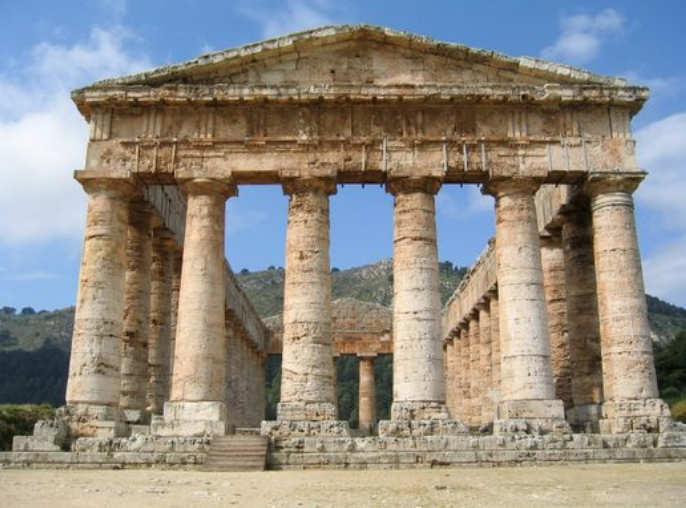
Doric architecture is a style of ancient Greek architecture that emerged in the 7th century, but really reached its peak in the 5th century which is contemporary to the Unfinished Temple of Segesta. Typically, key features of Doric architecture include the following …
Column Style: Doric columns are characterized by their simplicity and strength. They typically consist of a smooth, sturdy shaft with no base, resting directly on the stylobate (the uppermost step of the temple platform). The shafts are fluted with shallow vertical grooves that run the length of the column.
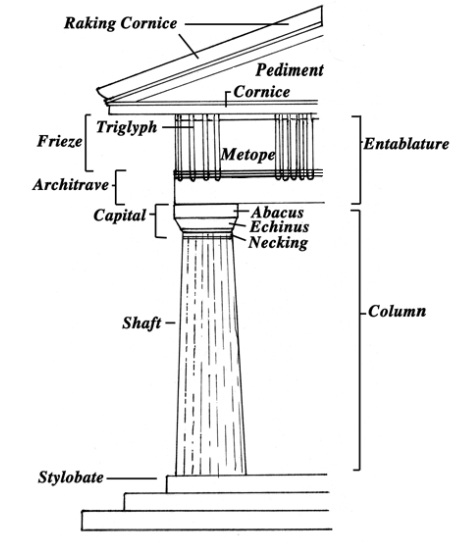
Capital: The capital of a Doric column is plain, consisting of a rounded section called the echinus and a square slab called the abacus. The echinus transitions directly into the square abacus without any ornamental features.
Entablature: The entablature of a Doric temple is divided into three main parts: the architrave, frieze, and cornice. The architrave is a plain, horizontal beam that rests directly on the columns. Above the architrave is the frieze, which typically features alternating triglyphs (vertical grooves) and metopes (plain or decorated panels). Finally, the cornice is the projecting molding that crowns the entablature.
Triglyphs and Metopes: Triglyphs are vertical grooves or channels that alternate with metopes in the frieze of a Doric temple. Triglyphs are thought to represent the ends of wooden beams used in early construction, while metopes originally displayed sculptural reliefs or paintings.
Roof: Doric temples typically had simple, gabled roofs made of wood, clay tiles, or marble slabs. These roofs were often supported by wooden beams and trusses hidden behind the entablature.
Proportions: Doric temples adhere to strict principles of proportion and symmetry, with careful attention given to the relationship between the column height, spacing, and overall dimensions of the building.
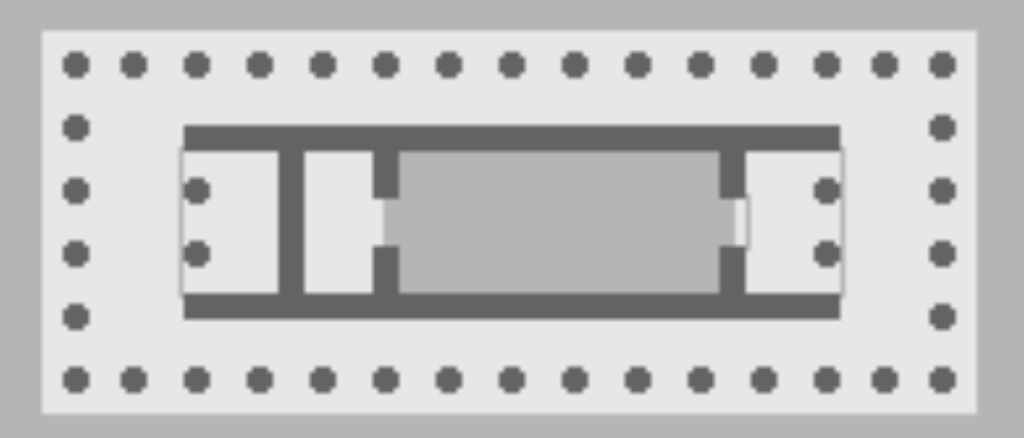
With this in mind about normal Doric architecture and Doric style temples, it can be determined that the Temple of Segesta was not finished.
Historical Details
Several features of the Unfinished Temple of Segesta suggest that it was left incomplete:
Lack of a Roof: One of the most prominent indicators of the temple’s unfinished state is the absence of a roof. Doric temples typically had roofs made of wood, clay tiles, or marble slabs, yet the Temple of Segesta lacked this essential architectural element. The absence of a roof exposes the inner chamber of the temple, leaving it exposed to the elements.
Missing Cella: The temple lacks a cella, which is a central chamber or sanctuary within the temple where cult statues or sacred objects were housed. In completed Doric temples, the cella served as the focal point of religious rituals and ceremonies. The absence of a cella suggests that the temple’s interior was never fully constructed or furnished.
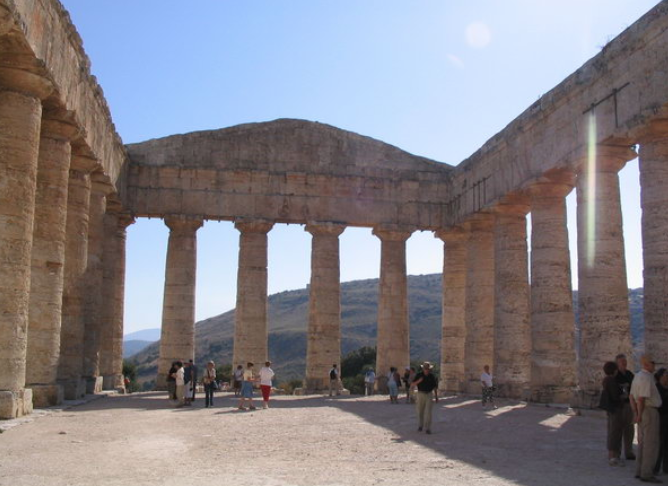
Unadorned Capitals: The capitals of the temple’s columns remain unadorned, lacking the intricate carvings or decorative elements typically found in completed Doric temples. The plain capitals suggest that the temple’s construction was halted before the decorative finishing touches could be applied.
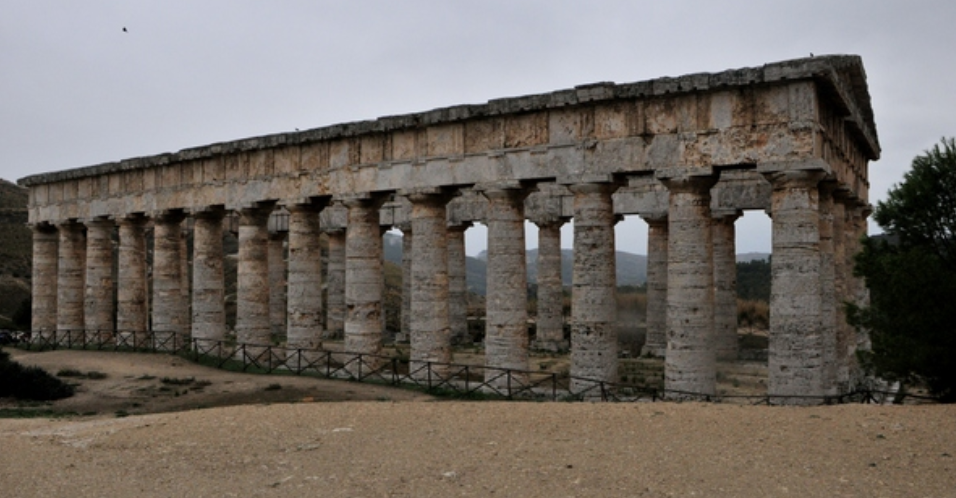
Rough Stonework: Examination of the temple’s stonework reveals rough surfaces and unfinished details, indicating that the construction process was abruptly halted. In completed temples, stonemasons would meticulously carve and polish the stone to achieve a smooth and uniform finish. The rough stonework of the Unfinished Temple of Segesta suggests that the construction was left incomplete before the final detailing could be completed.
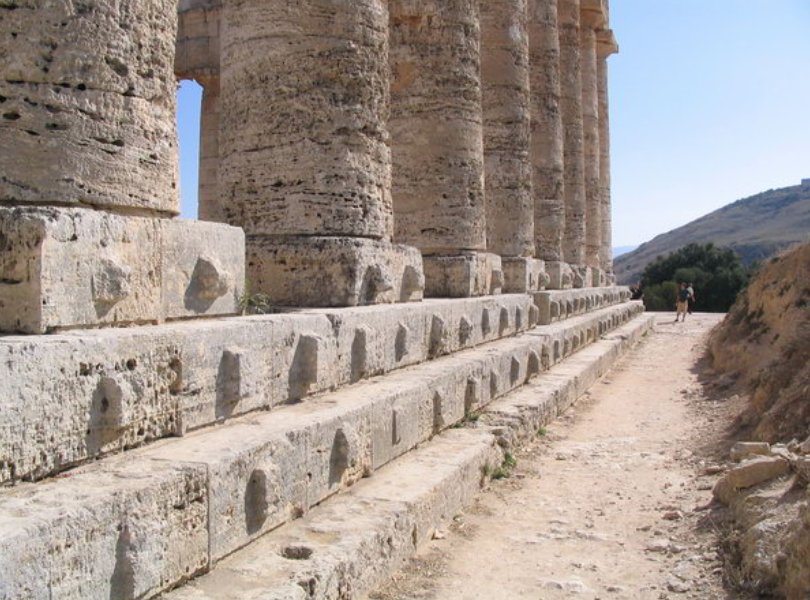
Absence of Inscriptions: The temple lacks inscriptions or dedicatory plaques typically found in completed temples, which would provide information about its purpose, builders, or patrons. The absence of inscriptions adds to the mystery surrounding the temple’s unfinished state and the circumstances of its construction.
Overall, the combination of architectural features such as the lack of a roof and cella, unadorned capitals, rough stonework, and absence of inscriptions strongly suggests that the Unfinished Temple of Segesta was left incomplete before it could fulfill its intended purpose as a fully functioning religious or civic structure.
Why was the Temple at Segesta left unfinished?
The Unfinished Temple of Segesta was likely left incomplete due to a combination of historical, political, and economic factors:
Conflict and Warfare: Segesta, like many ancient cities, was subject to frequent conflicts and wars. The temple’s construction may have been interrupted or halted altogether as a result of military conflicts, such as the ongoing struggles between Segesta and neighboring Greek colonies like Selinus. Warfare could have diverted resources and manpower away from construction projects, leading to the abandonment of the temple.
The Peloponnesian War: During the Peloponnesian War, the Athenians intervened in Sicily in response to appeals for assistance from Segesta (Egesta) against its rival city of Selinus. The Athenians saw an opportunity to expand their influence in the western Mediterranean and gain access to the island’s resources. The Segestans, in their appeals to Athens, exaggerated their wealth and resources, leading the Athenians to believe that they would find ample supplies and treasure in Sicily. This misinformation played a significant role in the Athenian decision to launch the ambitious Sicilian Expedition. The Athenian commanders, including Alcibiades and Nicias, made several strategic errors during the expedition. Instead of focusing on their initial objectives, they became embroiled in lengthy sieges and failed to secure support from local allies. This lack of strategic foresight weakened the Athenian position in Sicily and contributed to their eventual defeat. The city-state of Syracuse, a powerful ally of Selinus, intervened against the Athenians, leading to a protracted and costly conflict. The Syracusans, under the leadership of figures such as Hermocrates, effectively resisted Athenian aggression and received support from other Sicilian cities opposed to Athenian expansion. The Athenians laid siege to Syracuse, hoping to capture the city and gain control of Sicily. However, the Syracusans, with the help of reinforcements from Sparta and Corinth, managed to break the siege and inflict heavy losses on the Athenian forces. The failure of the siege marked a turning point in the Sicilian Expedition and contributed to the eventual defeat of the Athenians as well as their ally, the Segestans. Eventually, Segesta was attacked and conquered by Selinus in 411 BCE.
Political Instability: Political instability within Segesta or its surrounding regions may have contributed to the temple’s unfinished state. Changes in leadership, shifting alliances, or internal power struggles could have disrupted the continuity of construction projects, including the temple.
Economic Constraints: Economic factors, such as financial difficulties or resource shortages, may have played a role in the temple’s abandonment. Building a monumental structure like the temple would have required significant financial resources, labor, and materials. Economic downturns, trade disruptions, or mismanagement of resources could have hindered the completion of the temple.
Loss of Patronage: The temple’s construction may have been initiated under the patronage of a particular ruler, faction, or community leader. If this patronage was withdrawn or lost, perhaps due to political or economic reasons, the funding and support necessary for completing the temple would have been lacking, leading to its abandonment.
Shift in Religious Practices: Changes in religious beliefs or practices within Segesta’s community could have influenced the decision to abandon the temple. If the temple’s intended function or purpose became obsolete or irrelevant over time, there may have been little incentive to invest further resources in its completion. The temple also likely would’ve been used over time by different people. Discovery of a punic tomb inside the temple highlights the Carthaginian influence in the region in the mid-4th century B.C. It is likely that the temple was used by Greeks, native Sicilians, Carthaginians, and Romans all throughout the 5th – 1st centuries B.C.
Ultimately, the exact reasons for why the Unfinished Temple of Segesta was left incomplete remain speculative. However, a combination of external pressures, internal turmoil, and shifting priorities likely contributed to its abandonment, leaving behind a mysterious and enigmatic monument that continues to intrigue scholars and visitors alike.
Location and Contemporary Tourism
Location and Interaction
Situated atop Mount Barbaro, the temple overlooked the ancient city of Segesta, serving as a prominent landmark visible from afar. Its elevated position facilitated pilgrimage and worship, with devotees ascending the hill to participate in religious rituals and ceremonies.

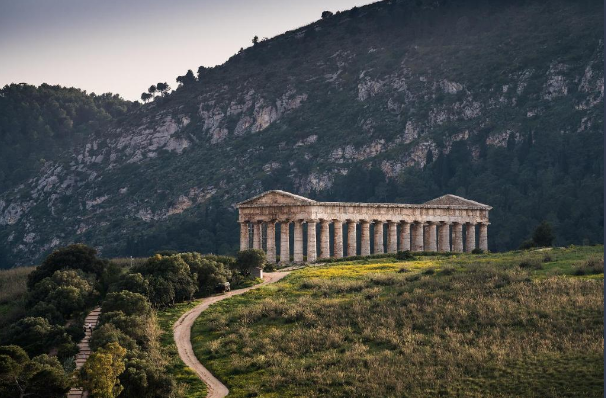
Inscriptions and Literary References
The temple lacks inscriptions, contributing to the mystery surrounding its purpose and construction. While not explicitly mentioned in literary sources, references to religious practices and political alliances provide valuable insights into the temple’s significance within ancient Sicilian society.
Condition and Conservation
Today, the Temple of Segesta stands remarkably well-preserved despite its unfinished state. Managed by the Regional Archaeological Park of Segesta, it remains a popular tourist attraction. Ongoing scholarly study and conservation efforts contribute to our understanding of ancient Greek architecture and its dissemination beyond mainland Greece.
Controversy and Significance
Controversies and Interpretations
Scholarly debates surround the temple’s interpretation, including questions of its builders and purpose. Some scholars argue for its attribution to the Elymians, while others consider Greek influence. Additionally, questions of cultural heritage and preservation persist, reflecting the complexities of managing and interpreting ancient sites. Recent discoveries of a Greek Altar near the site of the unfinished temple led scholars to further believe the original purpose of the temple was as a Greek religious site. It is unclear if this altar would have been located inside the temple or was housed in a nearby shrine, but the presence of other Greek religious practices highlights a certain baseline level connection to late fifth-century Greek culture.
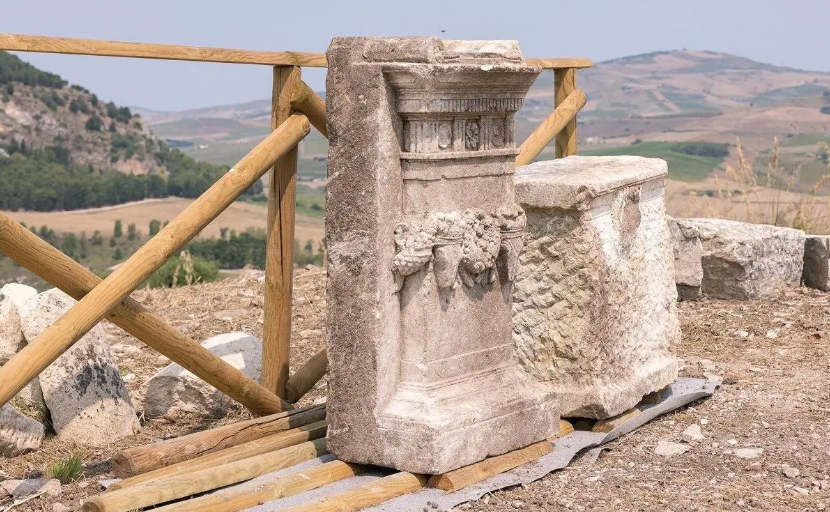
Significance and Conclusion
The Unfinished Temple of Segesta stands as a symbol of cultural exchange and religious significance in ancient Sicily. Its enduring legacy continues to inspire awe and fascination, inviting further exploration and interpretation by scholars and visitors alike.
Bibliography
Archaeological Park of Segesta. Accessed March 22, 2024. https://parchiarcheologici.regione.sicilia.it/segesta/.
Burford, Alison. “Temple Building at Segesta.” The Classical Quarterly 11, no. 1 (1961): 87–93. http://www.jstor.org/stable/637749.
“Calatafimi Segesta.” Visit Sicily. Accessed March 22, 2024. https://www.visitsicily.info/en/calatafimi-segesta/.
Cartwright, Mark. “Segesta.” World History. Last modified April 29, 2014. Accessed March 22, 2024. https://www.worldhistory.org/Segesta/#:~:text=Situated%20on%20the%20strategically%20advantageous,town%20of%20the%20Elymi%20people.
Cerchiai, Luca, Lorena Jannelli, and Fausto Longo (eds.). 2004. The Greek Cities of Magna Graecia and Sicily. Los Angeles: Getty.
Holloway, R. Ross. 1991. The Archaeology of Ancient Sicily. London: Routledge. https://weblogtheworld.com/countries/europe-countries/italy/sicily/segesta-greco-roman-ruins.
Mertens, Dieter. 1996. “Western Greek Architecture,” in G. Pugliese Carratelli (ed.), The Greek World (New York: Rizzoli), 315-46.
Miles, Margaret M. 2013. “Classical Greek Architecture in Sicily,” in SAI, 146-58.
Rolnick, Carol. “Segesta & the Ancient Greco-Roman Ruins of Sicily.” WeBlogTheWorld. Last modified February 17, 2018. Accessed March 22, 2024.
“Segesta’s Greek Temple and Theatre.” Italian Reflections. Last modified June 14, 2020. Accessed March 22, 2024. https://italianreflections.wordpress.com/2020/06/14/ segestas-greek-temple-and-theatre/.
“Segesta.” Livius. Last modified August 14, 2020. Accessed March 22, 2024. https://www.livius.org/articles/place/segesta/.
“Segesta.” Wonders of Sicily. Accessed March 22, 2024. https://www.wondersofsicily.com/segesta.htm.